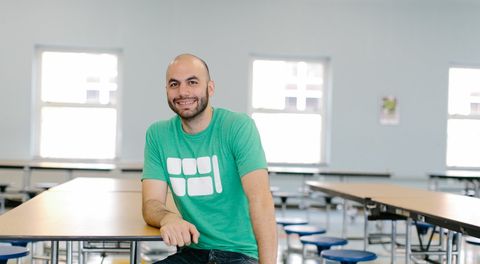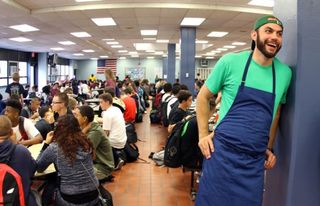
For most chefs, working at a Michelin-starred restaurant is a lifelong dream. But Dan Giusti traded his post as the head chef at Noma in Copenhagen, Denmark to start Brigaid, a company that operates kitchens in six public schools in New London, Connecticut. In 2018, Brigaid partnered with New York City Public Schools to transform the kitchens of six Bronx schools.
School lunches are typically bleak, conjuring images of soggy sandwiches or mushy pasta. But Giusti has transformed meals in the school kitchens that Brigaid operates with dishes made from scratch. Currently, the company recruits chefs, trains kitchen staff, creates menus and gets feedback from students.
Giusti talks to MensHealth.com about his inspiration to transform school cafeterias, the challenges of feeding young palates, and the worst lunches he’s ever seen.

Brigaid
MH: Can you explain how Brigaid works?
DG: We are a for-profit company that is working with public school districts who are operating the food service programs themselves. They do it all internally. We transition their offerings to scratch-made foods. We put a chef in each of those schools. We train the chefs, we help train the rest of the staff. We help the school with the procurement of new ingredients. We work with the students. The most important thing we can do is understand if they are happy or not. If the kids aren’t happy with it we are kind of missing the mark.
Why were you interested in school lunches?
There are no other places where you have access to people who need food everyday. This was the way you could cook for a lot of people often, which I wanted to do. In schools, we are feeding these kids every day for 16-17 years of their life. Young people are easier to get to in order to get them to open their minds about food, and that food is important. You can change the way they eat.
What are the worst things you’ve heard of kids eating at school?
It’s usually the lack of care and preparation. For example, you’ll see a muffin and it’s in a plastic bag, but it’s still kinda frozen in the middle, but it’s thawing on the outside. You’ll have this semi-frozen wet muffin inside of a plastic bag. That’s the kind of stuff you’ll see that’s kind of disappointing.
The kids have to eat it. They have to come back. You’re not fighting for business.
How do you make food that’s appealing to kids but still nutritious?
If I could tell you a clear-cut answer to that, I’d be a billionaire. It’s a tricky thing. It’s hard work, and it’s continuously just talking to students and trying to understand where they’re at and what they want.
One example of something that’s been a little more adventurous and a little more successful is a chicken curry dish. It has coconut milk. It has lemon grass. It has yellow curry powder, which is something a lot of our students weren’t familiar with. It’s served over steamed rice, which of course the kids are used to eating. It’s definitely accessible.
What’s the most surprising challenge about working in a school cafeteria rather than a Michelin-rated restaurant?
I think the hardest part of transitioning to school food is that everybody has a different idea of what is good and what we should be serving.
When you work in fine dining, people are coming to eat what you make. In schools, everybody has a different opinion on what’s right and what’s good. Getting into it, you think, “We’re going to make the food better and everybody is going to be happy about this.” But that’s not always the case. It’s a challenge to make everyone happy.
Source: Read Full Article
